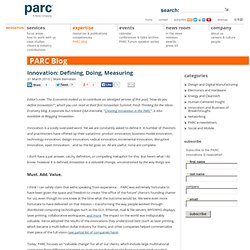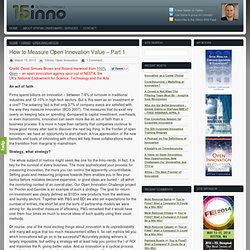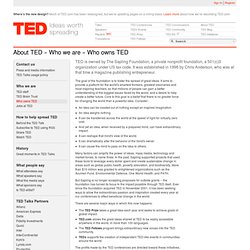

Crm. The Innovation Engine Community Powered by Maddock Douglas. Innovation: defining, doing, measuring. Editor’s note: The Economist invited us to contribute an abridged version of this post, “How do you define innovation?”

, which you can read at their first Innovation Summit: Fresh Thinking for the Ideas Economy blog. A separate but related Q&A interview, “Creating Innovation in the PARC“, is also available at Blogging Innovation. Innovation is a sorely overused word. Yet we are constantly asked to define it. A number of theorists and practitioners have offered up their variations: product innovation, business model innovation, technology innovation, design innovation, radical innovation, incremental innovation, disruptive innovation, open innovation…and so the list goes on. I don’t have a pat answer, catchy definition, or compelling metaphor for this. Must. Today, PARC focuses on “valuable change” for all of our clients, which include large multinational companies from different industries to startups incubated on site from our own work or select entrepreneurs.
A Changing Model. How do you define innovation? Ideaken blog - collaborate to innovate. Making innovation a systemic capability. Blogging Innovation - Innovation blog articles, videos, and insi. BCG_Innovation_2009_Apr_2009.pdf (application/pdf Object) How to Measure Open Innovation Value – Part 1. Credit: David Simoes-Brown and Roland Harwood from 100% Open – an open innovation agency spun out of NESTA, the UK’s National Endowment for Science, Technology and the Arts.

An act of faith Firms spend billions on innovation – between 7-8% of turnover in traditional industries and 12-15% in high-tech sectors. But is this seen as an investment or a cost? The sobering fact is that only 37% of company execs are satisfied with the way they measure innovation (BCG 2007). The measures that do exist rely overly on keeping tabs on spending.
Innovating to Compete - Innovation blog art. By Drew Boyd Innovating is a form of competitive behavior.

When we innovate, we compete with someone or something. We innovate to survive. We innovate for glory. We innovate to win. Innovating to compete occurs at many levels: Eduforge: Welcome. The Push/Pull Struggle of Innovation. Most Innovative Companies of 2010. Peter Drucker on the Seven Sources of Systematic Innovation. When Peter Drucker died, his obituaries were so laudatory I thought that I really should become familiar with his work.

So I’ve been reading through some of his major books. It’s striking how well-written and timeless they are. I just finished his classic “Innovation and Entrepreneurship“. For my purposes in working with funds to identify attractive investments, the most interesting and pertinent part of the book is his exploration of how to identify entrepreneurial white space. He writes that systematic innovation means monitoring seven sources for innovative opportunity. 1. 2. 3. 4. The second set of sources for innovative opportunity involve changes outside the enterprise or industry:
Next-Economic-Paradigm1.pdf (application/pdf Object) The agency for companies driven by innovation. What the Connected Company Looks Like. The Internet has changed the scale at which we can observe and participate in activities that express or pay off our own human nature - that of being social. As technologies get cheaper and more ubiquitous, more people can join in, independently of social status, geography, age, etc. Before the Internet, businesses were the center of our active social lives - especially in the last ten years, and for most, not all, of us.
Businesses replaced the local community as the center of our attention - and time spent - but often only for that. Businesses, as represented by companies, have become the most efficient possible without the injection or re-insertion of the human voice in them. Many business have done such a good job of exploiting the resources at their disposal - human or otherwise - that they have, in fact, become useless. According to Umair Haque, socially useless business is the status quo — and the status quo says: "You don't matter. The Character and Make of the Connected Company. Who owns TED. The goal of the foundation is to foster the spread of great ideas.

It aims to provide a platform for the world's smartest thinkers, greatest visionaries and most inspiring teachers, so that millions of people can gain a better understanding of the biggest issues faced by the world, and a desire to help create a better future. Core to this goal is a belief that there is no greater force for changing the world than a powerful idea. Consider: An idea can be created out of nothing except an inspired imagination. An idea weighs nothing. Many factors can amplify the power of ideas: mass media, technology and market forces, to name three. But Sapling is no longer accepting proposals for outside grants -- the foundation has turned its focus to the impact possible through TED itself.
There are several major ways in which this now happens: The TED Prize takes a great idea each year and seeks to achieve goals of global impact. How you can help: Big Ideas Fest. Business Strategy Innovation - Increase your profits and innovat.